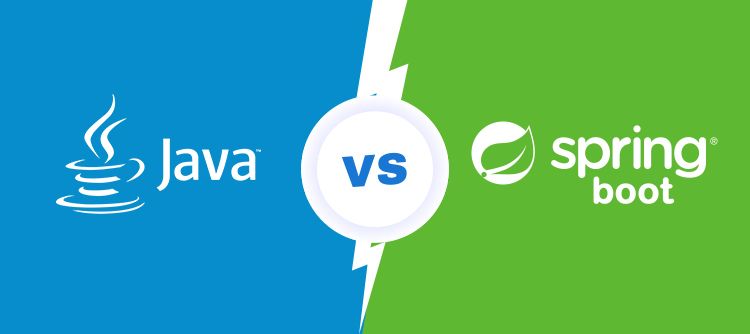
Subscribe to our Blog
We're committed to your privacy. SayOne uses the information you provide to us to contact you about our relevant content, products, and services. check out our privacy policy.

Jibu JamesJanuary 9, 202312 min read

Generating table of contents...
For the past 2 decades, the quest has been to point out the differences between Spring vs. J2EE. A few years ago, Spring held the fort as it was light and simple to handle. However, with the evolution of Java Enterprise Edition (also known as Java EE and J2EE), it has become the industry standard for many enterprises around the globe. In this blog post, we attempt to present a brief overview of their features, their advantages and disadvantages and the differences between the two in terms of performance, speed, scalability, applicability, and architecture.
The open-source Spring application framework provides infrastructure support for developing extensive Java applications. In the Java EE frameworks, Spring helps the developers of Java Application Development Company to create high-performance applications using the POJOs (plain old Java objects).

Java Platform, Enterprise Edition is an evolved set of specifications around the Java Standard Edition (Java SE). This advanced version provides distributed computing and web service features. Oracle states that Java EE has improved API programming features that suit modern software architecture models. All the below-mentioned features are listed in the software documentation.
These features also suit its vast community of developers..
The global market perceives J2EE as the second-most popular programming language among developers. Approximately, 1 million websites in the world use Java EE, with almost a third of them being in the USA.
Spring is an open-source lightweight framework that is used to build applications (REST APIs). The Spring framework allows a developer to write enterprise Java applications and along with Spring Boot, it makes it easy to create production-grade standalone enterprise-class solutions (such as for microservices).
Whereas the key feature of Spring is dependency injection it is auto configuration for Spring Boot. Therefore, together with Spring Boot Framework developers can cut down on development time and effort, and display increased productivity.
Spring allows the development of:
Read our blog “Outsource Java Spring Boot Services To India”.
Spring is purported to be the most popular Java framework that has been used in the recent past. Many live websites have used this technology.
Continuing comparisons on Java EE vs. Spring, let us see some advantages of Spring:
|
Java EE |
Spring |
|
It is a Sun/Oracle standard/specification |
Spring is a framework |
|
Is used for web development |
Is used for a template design for applications |
|
Has an Oracle based license |
Has an open-source license |
|
Based on 3D architectural frameworks; not necessary to use all of them |
Based on layered architecture with many modules - the three-tier architecture model |
|
Has an OO language that has a style and syntax |
Does not have a programming language |
|
Has good speed |
Slower than Java EE |
|
Can be web-based / non-web-based |
Is based on approximately 20 modules |
|
Has a GUI created from the abstract window toolkit |
Makes similar syntax IDE-independent |
|
Uses JTA API with the execution |
Provides a layer to help various JTA execution merchants |
Whereas Spring is a framework, Java EE is a specification. Spring framework nevertheless simplifies software creation based on the Java EE platform. Therefore, these two options can be considered complementary elements.
Java EE is one of the most in-demand programming languages and there are close to 9 million developers. Java can be used for simple software and enterprise-level solutions.
The average salary of an experienced Java developer In the USA is USD 100,000 per year. However, in some European nations, you can hire them at one-fourth of that cost.
Over half of Java developers are estimated to use Spring in their projects and the number of programmers with this tech stack is estimated to be approximately 4.5 million. Spring is frequently considered one of the best Java frameworks.
The average salary of an experienced Spring developer in the USA is USD 100,000 per year. Spring developers in Canada and the UK can be hired for 60 percent of this cost. It would be still cheaper in some Eastern European nations.
Java 19 is the latest version released (September 22). Some important additions are:
Java EE can be scaled vertically on a single system and across multiple systems horizontally. According to your requirements, you can also add more resources to your servers such as RAM and/or disk space. You can also add more machines/server nodes to work together.
The latest release version is Spring 5.3.23 (October 22). The Spring framework can be downloaded from the official website. You can also get other products such as Spring Boot, Spring Data, Spring Cloud, Spring for GraphQL, Spring Security, etc.
The current version has the following features:
Spring is almost as highly scalable as Java EE because it is the framework on top of the specification. Spring facilitates easy vertical and horizontal scaling models.
In Java EE, web services and applications are made of components that can be set in different containers responsible for security. The two types of security provided are:
Declarative security is the one in which the application’s security mechanism is both declared and handled by the application externally. This is made up of the application-level and component-level securities.
Download our eBook for FREE: “Global Software Development Rates – an Overview”.
Programmatic security is one in which an embedded solution is used typically when the declarative security by itself is not sufficient to build the required security model.
Java EE supports several must-have security features including authentication, data integrity, authorization, and transport security. It also runs with a virtual machine, adding another layer of protection.
Spring uses another product called “Spring Security” as a customizable access control and authentication framework.
Some of the features include:
Both Java EE and Spring can be used for modern web development, but Spring is often preferred for its ease of use, extensive ecosystem, and strong community support. Spring's auto-configuration and convention-over-configuration approach make it well-suited for building modern, scalable web applications.
It is an excellent choice for developing enterprise software, websites, web software, and EJB applications. This technology allows a high level of scalability, and you can move from an MVP to a full-fledged enterprise solution implementation quickly. It can be launched anywhere and does not depend on specific platforms.
Get in touch for a free consultation with our experts.
Choose Java EE to:
Popular apps built using Java EE are Twitter and Spotify, among others.
Spring simplifies the Java EE development process and makes it more lightweight. The framework provides many templates and using dependency injection, simplifies the testing process.
Use Spring to
Popular apps built using the Spring framework are Netflix and Blablacar.
Comparing Java EE and Spring leads many to question whether the two platforms are mutually exclusive, or if they can even exist within the same project. Another discussion centers on migration possibilities-from one to the other-and highlights the difficulties and advantages thereof.
Instead of choosing between Java EE and Spring, there's a practical option to combine the strengths of both. This hybrid strategy takes advantage of Java EE's robust enterprise features and Spring’s flexibility and simplicity.
Developers can leverage Java EE for enterprise-level capabilities like distributed computing and transaction management while benefiting from Spring’s ease of use, dependency injection, and dynamic ecosystem.
Integrating Java EE and Spring within a single application is not only possible but is increasingly common in complex enterprise projects. This approach allows teams to use Spring for business logic, benefiting from its modular design, while relying on Java EE for core infrastructure management.
However, a well-designed system is crucial to ensure compatibility and seamless interaction between components built on different frameworks.
Migrating between Java EE and Spring is a significant task that requires careful planning. The decision to migrate should be based on specific project needs, such as scalability, maintainability, or desired framework features.
Key factors include:
In many cases, the decision between Java EE and Spring is not exclusive. Enterprises often evolve to a point where both frameworks coexist, offering flexibility and the ability to leverage the best of each.
For migrations, a phased approach often works well. This method involves gradually shifting components or modules, allowing teams to manage risk and learn progressively.
Whether integrating Java EE and Spring or migrating between them, the ultimate goal is to harness the strengths of each to build scalable, maintainable, and high-quality enterprise applications.
Also Read:
Building Microservices Application Using Spring Boot & Cloud
Node.js vs Java spring boot for microservice

We're committed to your privacy. SayOne uses the information you provide to us to contact you about our relevant content, products, and services. check out our privacy policy.

About Author
Jibu James is the Team Lead at SayOne Technologies. He is passionate about all things related to reading and writing. Check out his website or say Hi on LinkedIn.

We collaborate with visionary leaders on projects that focus on quality